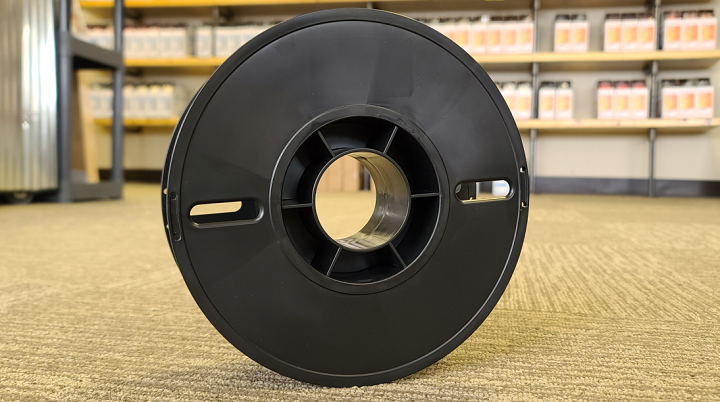Back in 2015, Fargo, North Dakota-based company 3DomFuel, Inc. announced its environmentally-friendly Eco-Spool, a 100% bio-based 3D printer filament spool made of bio-friendly materials that break down in landfills much more quickly than petroleum-based spools. The next year, the company’s 3Dom USA and 3Dom Europe branches partnered with another eco-friendly AM filament manufacturer, 3D-Fuel, to form 3DomFuel in order to expand production capabilities and come up with new ideas for high-quality, sustainable materials under the 3D-Fuel brand name. Now, just in time for Earth Day, 3DomFuel has announced an improvement to its products’ end-of-life options by way of the Eco-Spool2, which it calls the “first-ever enhanced landfill-biodegradable spool.”
The Eco-Spool2 is made with recycled HIPS (High Impact Polystyrene) that’s able to be recycled again, and as such, will be marked with the “6” recycle symbol. 3DomFuel will be using this new product for all of the 500g and 1kg spools in its US manufacturing facility, and also plans to use the new spools at its Ireland plant.
Because not everyone has access to recycling, 3DomFuel designed the Eco-Spool2 for better landfill biodegradation. Thanks to a newly acquired additive, which we’ll get to a minute, no special handling is required for the Eco-Spool2: you can just drop it in the trash can, and biodegradation is actually improved once this green print spool has been disposed of in a biologically active landfill.
3DomFuel and Ecologic, LLC, which makes the leading Eco-One technology used in the plastics industry, have entered into an exclusive agreement, which is how the Eco-Spool2 can achieve this improved biodegradation process. Eco-One, a 100% organic and non-starch-based additive, uses a series of biological and chemical processes to enhance biodegradation in a landfill, and is used in multiple plastic products, like apparel, footwear, sporting goods, foam, packaging, medical sanitation essentials, and now 3D printing.
“Over 90% of plastics end up in landfills. With our new enhanced biodegradability products, we can eliminate the 100’s or 1000’s of years required to break them down,” 3DomFuel wrote in a press release.
Once a plastic product made with Ecologic’s unique technology goes into a biologically active landfill, Eco-One’s ingredients make it possible for a coating, or biofilm, to form on the surface of the plastic. This biofilm is made up microbes that penetrate the plastic material, and Eco-One’s other ingredients team up to grow its molecular structure and make room for more microbes, which are attracted to the site thanks to the chemical signals that the existing microbes send out. Finally, after all the necessary microbes are there, they chow down on the plastic’s polymer chains, which then speeds up the breakdown of the product’s chemical bonds.
Thanks to this exclusive agreement with Ecologic, 3DomFuel will get to be the first to market with these new, environmentally-friendly products.
“From the beginning, 3D-Fuel products have been intended to be more sustainable and we have continually looked for a way to manufacture 3D printing materials with a minimal impact to our environment,” said 3DomFuel’s CEO John Schneider. “Finally, we have a way to produce products that truly are better for the environment with a range of end-of-life options as well as being easy to use and high-quality. We plan to soon have enhanced biodegradability as an option for all our products. We also encourage the entire 3D community to move in this same direction.”
3DomFuel now has exclusive rights to use the Eco-One additive in its 3D printing spools, which have been demonstrated by third party testing with the ASTM D5511 test method to enhance biodegradation in biologically active landfills. But the company has even more exciting news—with this agreement, it also plans to develop a line of enhanced landfill biodegradable PLA filament that features Eco-One.
We’ve seen 3D printer filament spools reused to make other items before, which is definitely a more sustainable choice than some. But I like that this option doesn’t require us to do any extra work to help the planet—we can just toss the spool once it’s empty and then go on about our day, secure in the knowledge that we’ve done one small, green deed.
(Source: 3DomFuel)
Subscribe to Our Email Newsletter
Stay up-to-date on all the latest news from the 3D printing industry and receive information and offers from third party vendors.
Print Services
Upload your 3D Models and get them printed quickly and efficiently.
You May Also Like
Reinventing Reindustrialization: Why NAVWAR Project Manager Spencer Koroly Invented a Made-in-America 3D Printer
It has become virtually impossible to regularly follow additive manufacturing (AM) industry news and not stumble across the term “defense industrial base” (DIB), a concept encompassing all the many diverse...
Inside The Barnes Global Advisors’ Vision for a Stronger AM Ecosystem
As additive manufacturing (AM) continues to revolutionize the industrial landscape, Pittsburgh-based consultancy The Barnes Global Advisors (TBGA) is helping shape what that future looks like. As the largest independent AM...
Ruggedized: How USMC Innovation Officer Matt Pine Navigates 3D Printing in the Military
Disclaimer: Matt Pine’s views are not the views of the Department of Defense nor the U.S. Marine Corps Throughout this decade thus far, the military’s adoption of additive manufacturing (AM)...
U.S. Congress Calls Out 3D Printing in Proposal for Commercial Reserve Manufacturing Network
Last week, the U.S. House of Representatives’ Appropriations Committee moved the FY 2026 defense bill forward to the House floor. Included in the legislation is a $131 million proposal for...




































